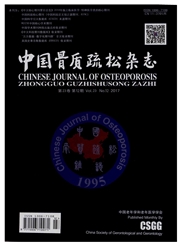

 中文摘要:
中文摘要:
目的研究补肾中药血清对离体SD大鼠成骨细胞中Smad1/5活性的变化。方法采用多次胶原酶消化法获取新生SD大鼠颅盖骨中的成骨细胞进行体外培养,并应用Gomori改良钙钴法对其进行碱性磷酸酶表达的鉴定;随机将实验用大鼠分为正常组、补肾中药组(补肾组)、骨疏康颗粒对照组(骨疏康组)、补中益气颗粒对照组(补脾组);对实验大鼠给药干预8d后,通过血清药理学的方法使用各组大鼠血清培养成骨细胞48h;应用免疫组化SABC方法检测成骨细胞中Smad1/5的活性表达。结果补肾中药血清作用于体外培养的成骨细胞48h后对于成骨细胞的增殖具有明显的促进作用,其效果优于正常组(P〈0.01);成骨细胞中Smad1/5的活性表达,与正常组相比有所降低。结论成骨细胞中存在Smad1/5的表达,表明Smad1/5可能有促进成骨细胞分化、增殖的功能,对成骨细胞保持自身功能、维持骨密度的作用上发挥重要的作用。②具有益肾填精壮骨的补肾中药可以影响Smad1/5在成骨细胞中的表达,对于促进和维持成骨细胞的特性及功能具有重要作用,这可能是防治骨质疏松症的机理之一。
 英文摘要:
英文摘要:
Objective To study the effect of kidney-tonifying Chinese herb-conditioned serum on the activity of Smad1/5 in rat osteoblasts in vitro.Method The osteoblasts in the cranial bone of newborn SD rats were collected using repeated collagenase digestion method and cultured in vitro.The expression of alkaline phosphatase was measured using the modified Gomori cobalt calcium method.The experimental rats were randomly divided into normal group,kidney-tonifying Chinese herbs group(kidney-tonifying group),Gushukang particle control group(Gushukang group),and invigorating spleen-stomach and replenishing qi control group(tonifying spleen group).The osteoblasts were cultured in the conditioned serum from rats of different group after 8-day medicine intervention for 48 hours.The active expression of Smad1/5 in osteoblasts was measured using immunohistochemistry SABC method.Results The kidney-tonifying Chinese herb promoted the proliferation of osteoblasts in the 48-hour conditioned cultures in vitro.The efficacy of kidney-tonifying group is higher than that of the control group(P0.01).The active expression of Smad1/5 in osteoblasts of the kidney-tonifying group was lower than that of the control group.Conclusion The existence of Smad1/5 in osteoblasts demonstrates that Smad1/5 can possibly promote the differentiation and proliferation of osteoblasts and play an important role to maintain the function of osteoblasts and bone mineral density.The Kidney-tonifying Chinese herb can influence Smad1/5 expression in osteoblasts and play an important role in promoting and maintaining the characterization and function of osteoblasts.This may be one of the mechanisms to prevent and treat osteoporosis.
 同期刊论文项目
同期刊论文项目
 同项目期刊论文
同项目期刊论文
 期刊信息
期刊信息
